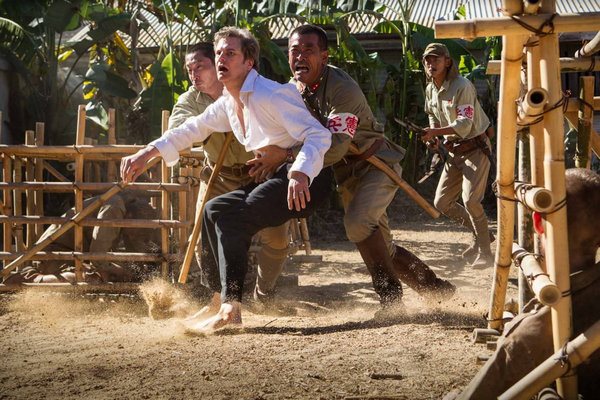The agony of war and of surviving it almost destroyed Eric Lomax. A British POW after the fall of Singapore who was put to work by the Japanese on the Burma Railway, he suffered brutal and prolonged torture, trauma he dealt with in subsequent decades by sealing it inside him, and plotting revenge on his abusers as he fell into troubled sleep. Lomax’s memoir The Railway Man describes this and the reconciliation with one of his captors which finally defined his life.
The week after Mandela: Long Walk to Freedom, Jonathan Teplitzky’s film again shows a man’s extraordinary capacity for forgiveness. It also goes further than The Bridge Over the River Kwai, which Lomax thought sanitised, in indicating the relentless savagery which he forgave.
 Casting Colin Firth as Lomax is the film’s great coup. Its producers wanted an actor who doesn’t quite exist anymore, someone like the deeply moving Robert Donat, whose quiet decency, dignity and humour exemplified Britain’s wartime ideal (and which Alec Guinness’s Kwai officer tragically perverted). After The King’s Speech, the more substantial wartime sacrifice of this hero combines Firth’s own instinct for tasteful reserve with his capacity for naked emotion.
Casting Colin Firth as Lomax is the film’s great coup. Its producers wanted an actor who doesn’t quite exist anymore, someone like the deeply moving Robert Donat, whose quiet decency, dignity and humour exemplified Britain’s wartime ideal (and which Alec Guinness’s Kwai officer tragically perverted). After The King’s Speech, the more substantial wartime sacrifice of this hero combines Firth’s own instinct for tasteful reserve with his capacity for naked emotion.
As Canadian nurse Patti Wallace, Nicole Kidman thinks she is meeting a repressed British gentleman in her own Brief Encounter when she starts talking to Lomax on a train in 1980, and they swiftly marry. When Lomax writhes and screams with nightmares on the bedroom floor, and his retreat into himself brutally consumes their marriage, she realises stiff upper lips can snap and scar (a Lomax nightmare of being back in the camp is pictured above).
 The initially charming Firth-Kidman romance (pictured left), and Kidman’s part in the film, are soon subsidiary to an extensive wartime flashback, first teased out of Stellan Skarsgaard’s fellow veteran. Jeremy Irvine matches Firth as the bespectacled, 21-year-old Lomax, a rail enthusiast thrust into horror far from his Scottish home. He rigs a radio to keep spirits up with news of the war’s changing fortunes, as the POWs chip a 250-mile rail line out of towering rock and jungle with picks and spades, in shocking heat and humidity. Over 9,000 British and Australian soldiers died doing so, and over 80,000 local workers. The British Empire also used “native” labour to carve out Asian railways, and the moral murk of a war between competing colonial powers is indicated in a script by Frank Cottrell Boyce and Andy Paterson. But the degree of ruthlessness of the Japanese, and the innocence of Lomax after the radio is discovered and his long torture begins, is unanswerable.
The initially charming Firth-Kidman romance (pictured left), and Kidman’s part in the film, are soon subsidiary to an extensive wartime flashback, first teased out of Stellan Skarsgaard’s fellow veteran. Jeremy Irvine matches Firth as the bespectacled, 21-year-old Lomax, a rail enthusiast thrust into horror far from his Scottish home. He rigs a radio to keep spirits up with news of the war’s changing fortunes, as the POWs chip a 250-mile rail line out of towering rock and jungle with picks and spades, in shocking heat and humidity. Over 9,000 British and Australian soldiers died doing so, and over 80,000 local workers. The British Empire also used “native” labour to carve out Asian railways, and the moral murk of a war between competing colonial powers is indicated in a script by Frank Cottrell Boyce and Andy Paterson. But the degree of ruthlessness of the Japanese, and the innocence of Lomax after the radio is discovered and his long torture begins, is unanswerable.
The Railway Man is uneven in tone and takes great dramatic liberties, creating a climax in which Lomax not only confronts his interrogator Nagase (Hiroyuki Sanada) at the Death Railway tourist site where he works in the film’s present, but cages and means to kill him (unlikely to be encouraged when the BBC filmed the actual meeting in 1993). These heightened dramatic leaps are justified because, like every performance and especially Firth’s, they serve Eric Lomax’s extraordinary story.
Overleaf: watch the trailer for The Railway Man







 Casting
Casting  The initially charming Firth-Kidman romance (pictured left), and Kidman’s part in the film, are soon subsidiary to an extensive wartime flashback, first teased out of Stellan Skarsgaard’s fellow veteran. Jeremy Irvine matches Firth as the bespectacled, 21-year-old Lomax, a rail enthusiast thrust into horror far from his Scottish home. He rigs a radio to keep spirits up with news of the war’s changing fortunes, as the POWs chip a 250-mile rail line out of towering rock and jungle with picks and spades, in shocking heat and humidity. Over 9,000 British and Australian soldiers died doing so, and over 80,000 local workers. The British Empire also used “native” labour to carve out Asian railways, and the moral murk of a war between competing colonial powers is indicated in a script by
The initially charming Firth-Kidman romance (pictured left), and Kidman’s part in the film, are soon subsidiary to an extensive wartime flashback, first teased out of Stellan Skarsgaard’s fellow veteran. Jeremy Irvine matches Firth as the bespectacled, 21-year-old Lomax, a rail enthusiast thrust into horror far from his Scottish home. He rigs a radio to keep spirits up with news of the war’s changing fortunes, as the POWs chip a 250-mile rail line out of towering rock and jungle with picks and spades, in shocking heat and humidity. Over 9,000 British and Australian soldiers died doing so, and over 80,000 local workers. The British Empire also used “native” labour to carve out Asian railways, and the moral murk of a war between competing colonial powers is indicated in a script by 
